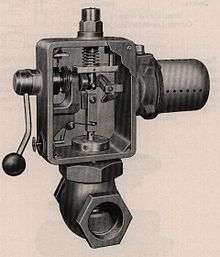Safety shutoff valve

Principle
When this type of valve is tripped, the flow is quickly stopped and an indicator disc tells the operator that the electrical circuit has been opened by a failure somewhere in the system. When the system failure has been corrected so that the circuit is again closed, the valve can be opened by the action of the hand lever. If, however, the system failure has not been satisfactorily corrected, the circuit will remain open and moving the hand lever will not open the valve, because the valve stem remains disengaged from the handle.
In a solenoid-operated safety shutoff valve, a spring action closes the valve instantly when an electric current fails and the solenoid ceases to be energized. The solenoid circuit is generally arranged so that it is broken upon failure of any element of the system. This valve cannot be re-opened until the solenoid is again energized.
A safety shutoff valve should be fail-safe, that is close upon failure of any element of the input control system (such as temperature controllers, steam pressure controllers), air pressure, fuel pressure, current from a flame detector, or current from other safety devices such as low water cutoff, and high pressure cutoff.
However, sudden closing of a valve in a piping system may lead to water hammer or implosion so in special cases there may be additional items connected to the shutoff valve, such as a pressure relief valve or an aerator valve.
The coil of the valve solenoid must be connected in series with all of the elements. For this to operate, fuel, air and steam pressure can be converted to electrical signals by means of bellows, a bourdon tube, or a diaphragm-operated mercury switch.